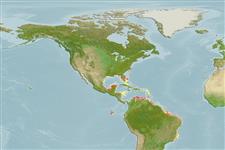Common names from other countries
Classification / Names / Names
Common names | Synonyms | Catalog of Fishes (gen., sp.) | ITIS | CoL | WoRMS
Environment: milieu / climate zone / depth range / distribution range
Ecology
Benthic; depth range 2 - 15 m (Ref. 116123). Tropical
Western Central Atlantic and East Pacific.
Length at first maturity / Size / Weight / Age
Maturity: Lm ? range ? - ? cm Max length : 30.0 cm TL male/unsexed; (Ref. 1840)
Neritic (Ref. 1840); coastal (Ref. 19) in shallow warm waters (Ref. 1840). Combination depth range: min from literature, max from estimate. Shallow, warm waters (Ref. 1840, page 44); coastal (Ref. 19).
Cutler, E.B. 1994. (Ref. 1840)
IUCN Red List Status (Ref. 130435)
CITES status (Ref. 108899)
Not Evaluated
Not Evaluated
Human uses
| FishSource |
Tools
More information
Common namesSynonymsPredatorsReproductionMaturitySpawningFecundityEggsEgg development
Age/Size
Growth
Length-weight
Length-length
Morphology
Larvae
Abundance
Internet sources
Estimates based on models
Preferred temperature
(Ref.
115969): 23.5 - 25.4, mean 24.2 (based on 43 cells).
Vulnerability
Low vulnerability (20 of 100).
Price category
Unknown.
